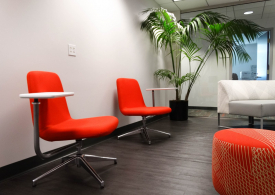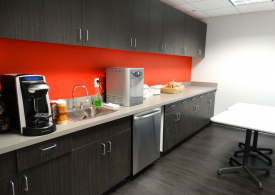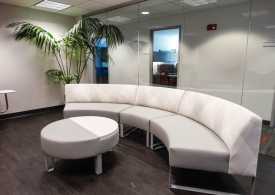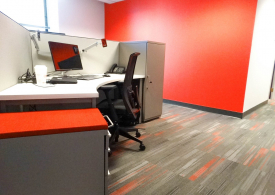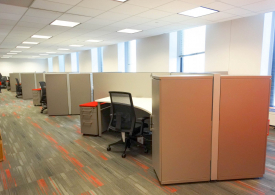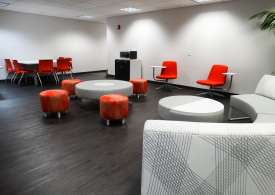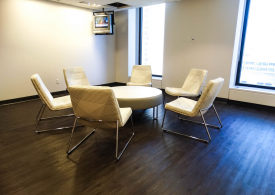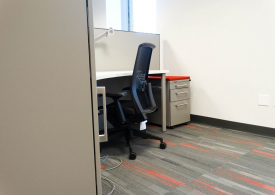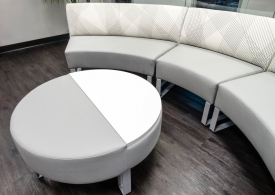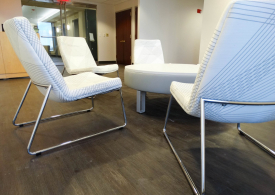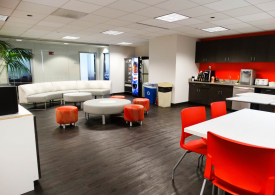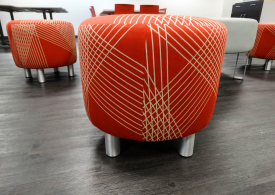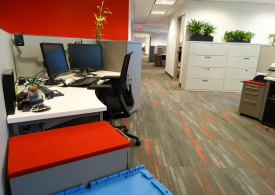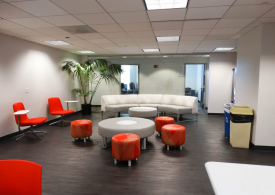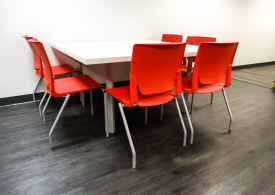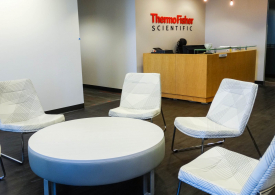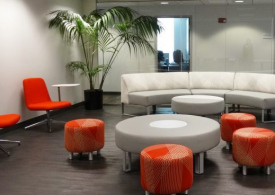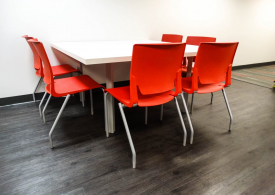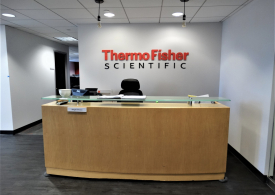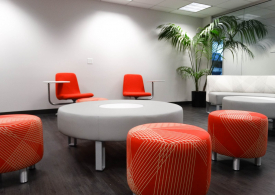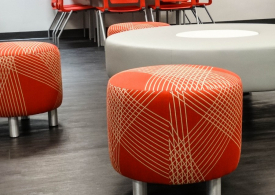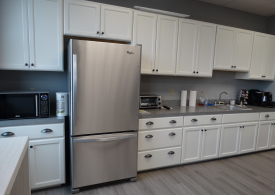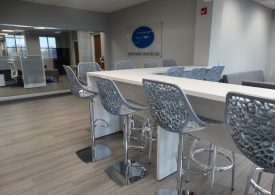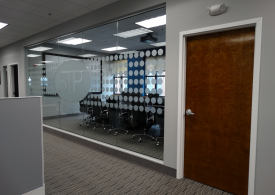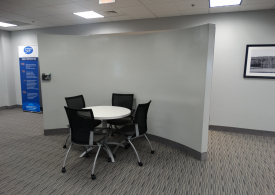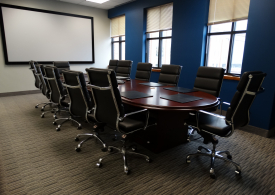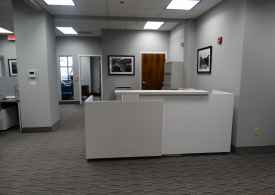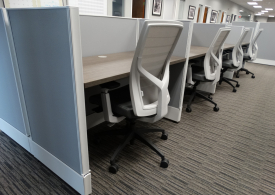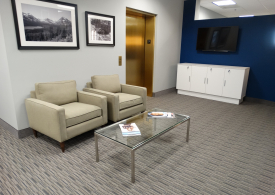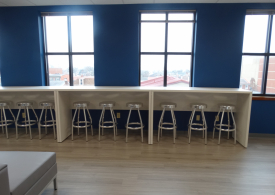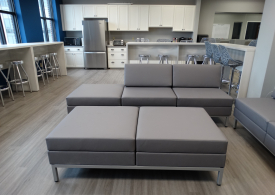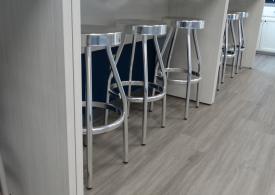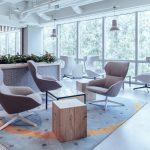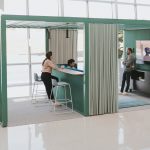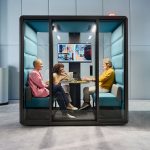Author Archives: Bellia Office Furniture
The impact of color in the workplace
When you look around your office, do you see bland white walls and no variety of colors? Then it might be time for a change. Business experts agree that color can have dramatic effects on the way employees feel, work and view their office environment. Further, scientific studies have found that certain colors in the workspace can have a direct effect on employee output like productivity and creativity.
Consider the following colors and the affect they will have on your employee output. Is it time to transform your space with color?
Blue/Green
Because these colors are found in nature, blue and green hues have a calming effect. Not only do blues and green create a calmer atmosphere, but they also improve efficiency, focus and create a sense of wellbeing for employees. Adding plants to your space is a great way to incorporate green into your space. Research has shown that their is a definitive link between the color green and increases in creativity.
Red/Orange
While most businesses are not going to choose to paint their entire office red (or orange), using these colors as accents can be highly impactful. Because these colors are active and intense, they increase energy. It is important to use to use them sparingly, because too much of an intense color can create stress and aggression in employees. Experts suggest using splashes of these colors in areas where employees which are not primary work areas like kitchens, hallways and even bathrooms.
Yellow
Yellow has long been associated with optimism, happiness and cheerfulness. But like red/orange, it is best to use yellow sparingly because of its intensity. Painting an entire room yellow can actually induce stress and agitation. By using yellow on accents walls or furniture, you can trigger innovation, creativity and energy in your employees. Bold colors, such as yellow, are often good colors to include with other muted shades in your logo, because they tend to draw the eye towards them.
Neutral Colors
Neutral colors have their place alongside brighter colors, they will often compliment other colors in your design scheme. Alone they are not particularly energizing or stimulating, but alongside bold colors they can create depth in your workplace design.
The colors you choose to use in your workplace will have a tremendous impact on your employees, both good and bad. The right colors in your workplace will influence employee happiness, productivity, creativity and energy in your space. So it is important when planning how to use colors in your design to turn to a knowledgeable professional design team who assist you in your color selection so that it aligns with your corporate goals.
3 Tips for Enhancing Recruitment and Retention
Attracting and retaining top talent and valuable employees depends on many different things. While often overlooked, workplace design is an important aspect of recruitment and retention After all, an office is a physical embodiment of a company and its culture. By strategically planning your workplace design to support your company’s culture and mission, it will have a direct impact on your company’s recruitment and retention.
When thinking about workplace design to support recruitment and retention, consider the following:
Your Space Should Support Your Mission and Culture
Your brand and your company’s culture should be clearly represented as a new recruits and longtime employees walk through your doors. When your mission and culture are consistently displayed through your office design, not only will your employees/recruits feel a sense of unity, but they will get a feel for the personality and culture of your business. Making strategic choices about logo, colors and furniture will connect everyone that walks through your doors to the values and attitude of your organization. Further, productivity can increase by as much as 20% when employees are in a workspace that they admire and feel positive about.
Your Space Should Be Flexible
For top talent, a workspace that is flexible and has a variety of areas to work in has a lot of appeal to both top talent and current employees. The new workforce, many coming from a collegiate atmosphere, want to be able to have the choice to work in space that suits them best. The type of work environment that works best can change often based upon the type of work an employee is asked to do, so including a combination of areas for employees to work will enhance recruitment and retention. Consider including open and enclosed areas for collaboration or focused work and places to relax and socialize such as comfortable seating areas, kitchens or cafe areas. Recent studies have shown that employees that are given choice in their work environment have higher growth rates and one-third the turnover.
Your Space Should Have Easy Access To Technology
Flexibility is a big selling point in attracting top talent and keeping current employees happy–having a workspace that is integrated with state-of-the-art technology will not only provide a flexible work environment but support an atmosphere of innovation, creativity and collaboration. When employees have easy access to technology, it becomes a very important benefit of their jobs. In a workspace where technology is up-to-date and easy to use, employees will have the option to work remotely, have improved collaboration and added flexibility.
By investing in workplace design as a way to enhance your recruitment and retention, you can strategically create not only a space where employees and recruits will want to work, but create a space that will inspire and engage them, making your company a place that will stand apart from the rest.
Thermo Fisher Scientific
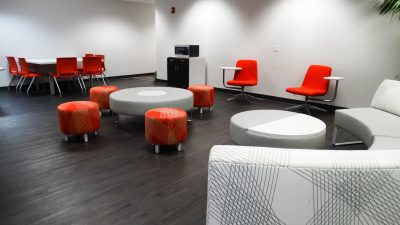
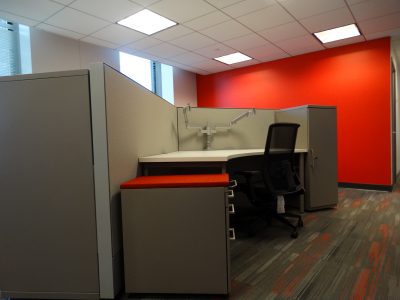
1601-1645, Cherry Street, Philadelphia, PA 19102
Thermo Fisher Scientific needed their existing space to:
- Accommodate their rapidly growing business and client base.
- Support collaboration and help their team reach new levels of innovation.
- Boost productivity and morale.
Their new space incorporated a modern vibe and gave staff both wide-open, inviting spaces as well as more private office spaces. Bellia was able to transform their conference room into a technology accessible, clean, comfortable space. The lobby is sleek, features clean lines, and is a pleasant reception space for new clients and staff.
Whitepaper: Economics of Ergonomics
Being able to discuss with management the costs of work-related musculoskleletal disorders (WMSDs) and the performance losses associated with them is beneficial when trying to justify the purchase of “ergonomically” designed office furniture. This paper from Haworth discusses the steps involved in the process to cost justify ergonomic changes.
Planning For Generation Z
While the Millennials will make up 40% of the workforce by the year 2020, Generation Z is right behind them.
Who are They?
Generation Z or iGen (with a lowercase i–because they are cloud natives not digital natives like the Millennials) were born after 1996, according to the Center for Generational Kinetics. Gen Z or iGen is the first generation to be raised in the smartphone era; they can create a document, edit it, post a picture to Instagram and talk on the phone all at the same time. Further, they have no concept of what life was like before social media. Because they are so social media minded, they have become very aware of how to create their own personal brand. They are very conscious about the image they wish to convey to the world, primarily through social media.
So, what does that mean for your business? Gen Z are hardworking, conscientious and are concerned about the future, so they will make great employees. While Millennials cared most about having the feeling that they personally mattered and were making a difference in an organization, Gen Z is looking for safety and stability. They want independence, they are fiercely competitive and are looking for opportunities to advance within a company. Like the Millennials, they still want consistent and regular feedback on the way they are performing in their positions.
Now that you have a better idea about the characteristics and work styles of Generation Z, let’s explore how that will impact office design. Here are just a few design features that will appeal to the next generation workforce.
COLLEGE LIKE SPACES
In a recent whitepaper by KI, it was discovered that almost 90% of recent college graduates experience difficulty in making the transition from collegiate atmospheres to their new physical work environment. Borrowing design and workspace planning ideas from institutions of higher education will not only create an easier transition for the new workforce, but can bring about positive changes to the existing environment, including greater productivity and collaboration for the new and existing workforce.
TECHNOLOGY
Gen Z’s are known to be tech-savvy. But just because they are, they might not be able to easily navigate your company’s software if it is outdated. Because they are a generation that are used to using Instagram and Snapchat, embracing new technology and having updated apps and software will not only help them perform better, but increase efficiency and productivity as well.
NOISE CONTROL
While open office design has countless benefits including maximizing space per square foot, encouraging collaboration and flexibility, it can be too noisy. By including quiet zones and private areas in your workspace design where employees can focus and complete independent work, there is a space for everyone to work where they feel most comfortable.
Benefits of a Branded Workspace
Each year, businesses spend millions of dollars promoting their brands through advertising and marketing. While marketing your brand through advertising is critical, your workspace is also essential in promoting your brand and the message you want employees and clients to receive about you. As you take a look at your current space, is it reflecting your brand? Is it effectively conveying your message?
A branded workspace should not only be about displaying your company logo and colors in your lobby but using the entirety of your space to communicate your message. Your office has the potential to be your most valuable brand messenger. In order to make your workspace support and reflect the essence of your brand, it is important to consider some of the benefits a branded workspace can bring to your business.
The Power of Your Employees
While the most common way to deliver your brand message is through marketing and advertising, your employees are often the best way to strengthen and reinforce your brand. By creating a branded workspace, employees will feel connected with your organization’s message and values. A good way to create a consistent visual reminder for employees about how your brand should be portrayed to clients is to inject your brand into every area of your workspace including meeting rooms, kitchens, and lobbies. A branded workspace also shows that your organization values and is committed to the well-being of your employees. It is a constant reinforcement to your staff that you care about them as much as you care about your clients. Studies have shown that companies that have a branded workspace have more engaged employees. Employee engagement leads to increase in productivity and decreases in employee turnover.
Tell Your Story
There is no better way to connect to employees and clients than by using your workspace to tell your story. By creating a space where all who enter can experience your story, your history, your milestones and your achievements, it will inspire and create a feeling of belonging. Telling your story through design elements will communicate that your company stands apart from the rest and subtly remind clients and employees what makes your company uniquely you.
Here are 3 Ways to Brand Your Workspace
1 – Signage
Your company’s name, logo, and colors are a critical part of branding. As your employees and clients walk through your doors, it should be the first thing that they see. Your signage should also be a reflection of your business.
2 – Floor plan
Your floor plan should be carefully considered in a branded workspace. If your company is innovative and collaborative, a closed door, private office layout will not convey the right message about your brand nor will it maximize productivity. However, if you are a professional accounting firm, more private spaces will send a message to your client’s about the nature of your business.
3 – Color
Choosing colors that reflect the uniqueness of your brand is an easy way to send a message. You can add subtle splashes of color in furniture, upholstery, and artwork in common areas that will help bring your brand to life.
A branded workspace has the power and potential to shape the way your company is perceived by your employees, your clients, and your investors. By hiring a team of professionals to help you create a branded workspace, you will communicate the values and mission of your business. When you use elements of design to reinforce your brand, not only will you see business growth, but increases in employee engagement, attract top talent, maximize productivity and see a return on your investment.
Are you ready to brand your space? Let the team of professionals at Bellia help you early in the planning process by conducting a complete analysis and provide solutions based on your goals.
Cultivating the Next Generation of Leaders
Recently the Chamber of Commerce for Greater Philadelphia conducted the Cultivating the Next Generation of Leaders in Greater Philadelphia Survey. This survey was designed to gain understanding of the personal, regional and professional motivators of the area’s emerging mid-career professionals. The survey yielded some interesting information about the professional lives of mid career professionals. At Bellia, our mission is to increase the magnetism of the Tri-state area, the information contained in this survey is important in understanding ways to attract and retain top talent in the region.
There are three important factors when considering a new employer, particularly for those ages 30-39 . They include company culture, opportunity to grow and work life balance.
Company Culture
Often, when job seekers don’t take the time to learn about a company’s culture before accepting a job offer, they join a company that disappoints them. Company culture plays an important role in whether your employees stay or go. Your company must consider how it is perceived by potential and current staff. Are you an organization that encourages collaboration and teamwork? How does your company get stuff done? Does your company stand behind strong core values that will appeal to job seekers?
Opportunity to Grow
One thing that is really important to new and mid-career professionals is the opportunity to learn, develop and grow in their company. While professional and formal training opportunities are important to potential employees, 90 percent of learning and opportunity happen on the job. So, job seekers are looking for a management culture that supports learning and development. Job candidates want to know that the person they report to is going to help them advance and grow in their careers.
Work/Life Balance
Work/life balance is generally refers to the idea that employees need to do more than just work. There needs to be a balance between work and other important parts of their lives including family, friends, community involvement, healthy living, etc. Because potential employees rank this as something that really matters to them, it is important that your company values it. When employees are bogged down with work, it ultimately will create stress and unhappiness in their jobs. Because many employees are motivated to succeed, they often lose a grasp on this balance, so employers can help them maintain a healthy balance by offering flexible scheduling, PTO and company sponsored family activities. When those at the top are achieving and modeling a work/life balance in their own lives, it creates an environment where it is expected from all employees to do the same thing, contributing to a positive culture.
By focusing on these aspects of your company, it will raise the magnetism of the area. By understanding what potential job seekers look for in choosing a new employer, you can make sure that you have what they want. Not only will it create an engaging and positive corporate environment, it will attract the best candidates to your company.
To see the full infographic/survey resuslts visit the Philadelphia Chamber of Commerce here.
Tips for creating an ideal healthcare atmosphere
The trend in healthcare design has moved toward making healthcare facilities resemble a spa like setting to help reduce the stress and worry that patients tend to face when entering a medical facility. A challenge that healthcare environments face when trying to fit the needs of the patients, visitors and staff, is that the space still needs to come off as clinical and professional in order to keep with the high standards that people have come to expect from a traditional medical office.
Further, the space should help you achieve your goals, such as increasing productivity, attracting top employees, and creating a positive, peaceful environment for patients, visitors and staff.
Here are a few trends and things to consider when considering a redesign of your healthcare facility.
IMPROVE PATIENT EXPERIENCE
There have been a number of studies done showing that the physical environment in the healthcare setting directly affects outcomes for patients. Current goals in design for medical facilities include utilizing high tech innovations where possible and to deliver an experience that feels safe, comfortable and instills confidence in patients and visitors. Some of the design elements that improve patient experience are:
BRING NATURE INDOORS
Research has shown that even just a short exposure to nature can reduce patient stress. So having plants, aquariums and even artwork displaying natural landscapes will create an environment that is stress-free and relaxing for patients, visitors and staff. Studies have linked nature in hospital and medical settings to have restorative and calming effects on sick patients and their families.
INCORPORATE NATURAL LIGHTING
Lighting is an important part of any space, but in healthcare settings, natural lighting plays a particularly important role. Studies have shown that exposing patients to natural light has positive impacts on patient outcomes and healing. Also, for employees, natural lighting has been found to increase productivity and efficiency and create an overall feeling of positivity in the workplace.
By designing healthcare facilities based upon the needs of patients, family and staff have an overall positive effect on everyone using the facility. For staff, a peaceful environment will increase effectiveness and morale and bring a return on investment. For patients, creating a warm and comfortable environment will have numerous health benefits.
Strategic Blueprint: Balancing Cost-Effectiveness with Support for Corporate Change & Flexibility
In recent years, organizations have increased their attention to facilities management — due in large part to a perceived need for increased consolidation in the procurement, specification, and project management of corporate office environments. As the cost of corporate real estate remains high, many companies consider facilities in terms of organizational efficiency and cost-cutting initiatives. However, this approach may need fundamental revision to keep up with the torrid pace of change within the knowledge economy.
In many corporations, the traditional view has been that in order to improve the bottom line, facilities costs must be kept to a minimum. One effect of this approach has been to increase the density of workers within office environments. Quite literally, many organizations measure building performance or efficiency in terms of how many workers they can accommodate with the least amount of floor space or technology support.
While this approach serves to maximize short-term returns on investments and assets, if the impact of employee turnover, absenteeism, and less-thanoptimal productivity are included in the measurement, the perspective that facilities costs represent mere red ink changes dramatically. If turnover or absenteeism drops — or productivity increases — even a few percentage points, the positive impact on the bottom line can be substantial, depending on company size. Over a ten-year period, the costs of employees’ salaries and benefits will be fully five to 13 times the costs of the initial investment in construction, furniture, interior furnishings, and equipment, plus building operations and maintenance, depending on proportion of leased to purchased real estate. The fact that personnel costs still represent the primary corporate expenditure — well ahead of facilities costs — suggests the need to treat space as an investment rather than as overhead. The potential for bottom-line impact from facilities has much more to do with support for knowledge work than with merely trimming costs. Read more by downloading this whitepaper from Haworth.
STP Investment Services Office Space

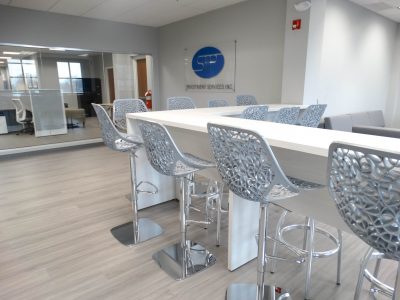
158 W Gay St #300, West Chester, PA 19380
STP Investment Services was looking to update their new location in order to:
- Allow for the growth their firm was seeing.
- Reflect their collaborative culture.
- Modernize their space to match their company mindset.
Bellia, as project manager, was able to deliver those desires AND more. First and foremost, the project was kept on budget and on time, alleviating any stress the process could have presented. Every area, from the lobby, to conference rooms, to offices, and cafe emulated a bright, inviting vibe. The office included open area workstations, meeting areas that made things feel less formal and “corporate” like, and a lounge area for breaks as needed. The new space is sure to attract top talent that will only continue to grow an already successful business.

